Mindfulness practices can significantly enhance the quality of life for patients with rare diseases by reducing stress and improving emotional well-being. This article explores tailored techniques that address unique patient challenges, highlights the benefits of mindfulness for emotional regulation and pain management, and offers practical integration strategies for daily routines. Understanding these elements can empower patients to better cope with their conditions and improve their overall satisfaction with life.
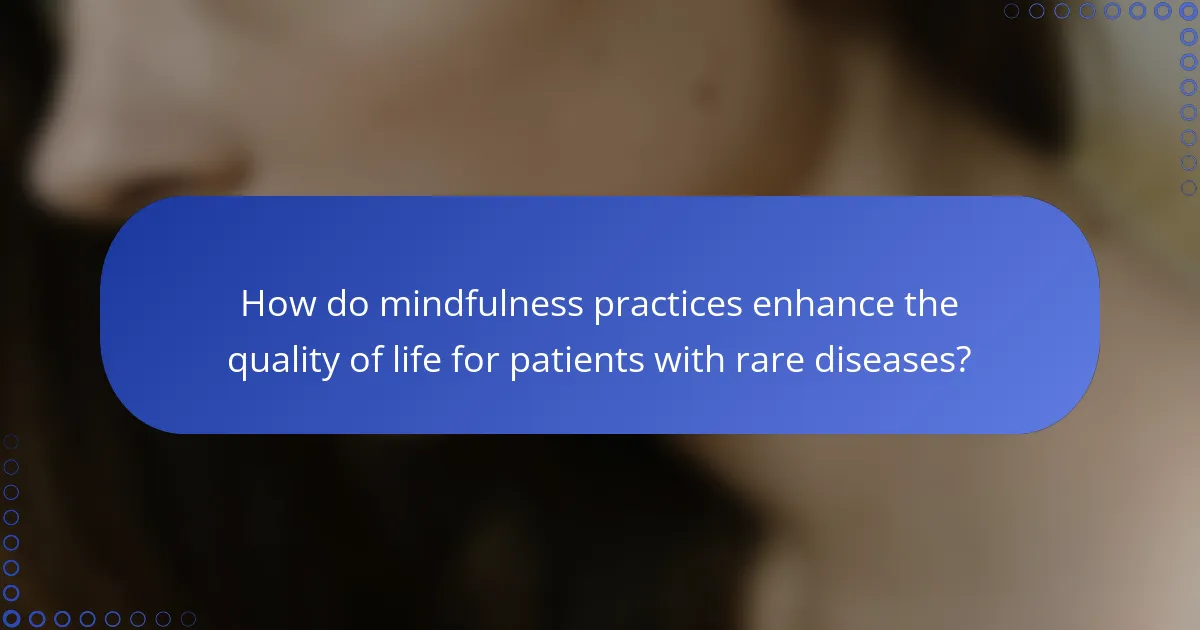
How do mindfulness practices enhance the quality of life for patients with rare diseases?
Mindfulness practices significantly enhance the quality of life for patients with rare diseases by reducing stress and improving emotional well-being. Techniques such as meditation and breathing exercises promote relaxation and resilience, enabling patients to cope better with their conditions. Research indicates that mindfulness can lead to decreased anxiety and improved mood, which are crucial for managing chronic health issues. Additionally, these practices foster a sense of community among patients, enhancing social support and overall satisfaction with life.
What are the core mindfulness techniques applicable to rare disease management?
Core mindfulness techniques for rare disease management include meditation, breath awareness, body scanning, and mindful movement. These techniques help patients reduce anxiety, improve emotional regulation, and enhance overall well-being. Meditation fosters a focused mind, while breath awareness aids in stress reduction. Body scanning promotes awareness of physical sensations, and mindful movement encourages gentle physical activity. Each technique contributes to better patient outcomes by enhancing resilience and coping strategies.
Which mindfulness practices yield the most significant psychological benefits?
Mindfulness practices that yield significant psychological benefits include meditation, breathing exercises, and mindful movement. These techniques enhance emotional regulation, reduce anxiety, and improve overall well-being. Research indicates that regular practice can lead to measurable decreases in stress levels and increases in life satisfaction. For instance, mindfulness meditation has been shown to decrease symptoms of depression by 30% in clinical studies.
How can mindfulness improve physical health outcomes for rare disease sufferers?
Mindfulness can significantly enhance physical health outcomes for rare disease sufferers by reducing stress and improving emotional regulation. Techniques such as meditation, breathing exercises, and body awareness can lower anxiety levels, which often exacerbate physical symptoms. Research indicates that patients practicing mindfulness report better pain management and increased quality of life. Additionally, mindfulness fosters a greater connection to one’s body, enabling patients to recognize and respond to their health needs more effectively. These practices can lead to improved adherence to treatment plans and better overall health management for rare disease patients.
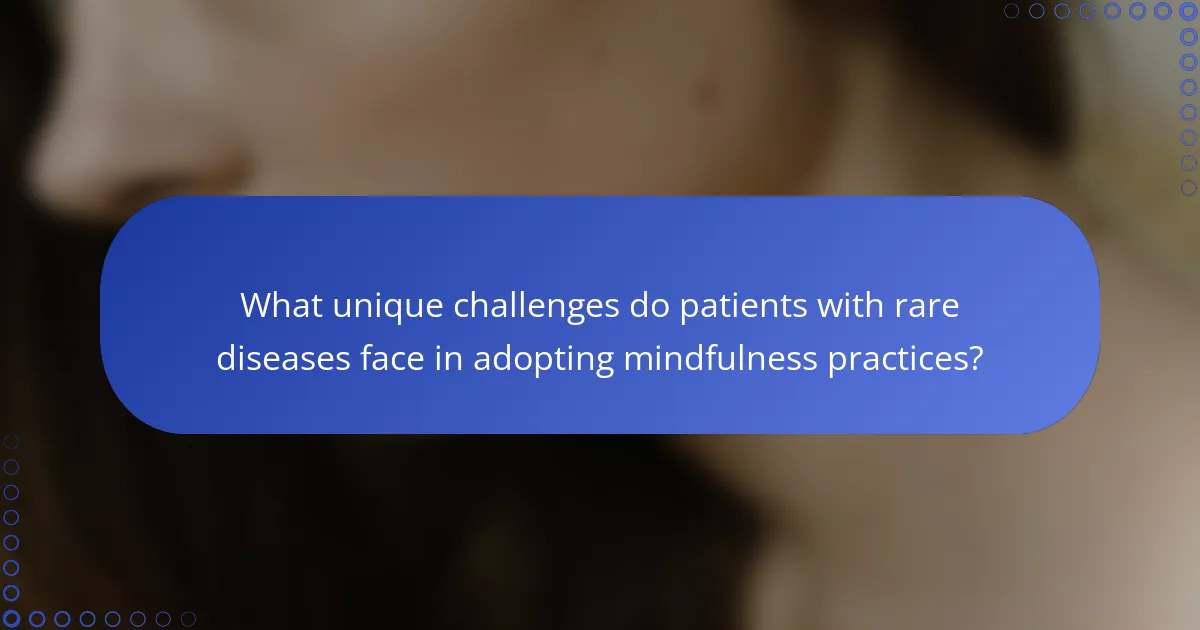
What unique challenges do patients with rare diseases face in adopting mindfulness practices?
Patients with rare diseases face significant challenges in adopting mindfulness practices due to their unique health conditions. These challenges include physical limitations, emotional distress, and the need for tailored techniques.
Physical limitations often hinder the ability to engage in traditional mindfulness practices, such as yoga or meditation. Many patients experience fatigue, pain, or mobility issues, making it difficult to participate fully.
Emotional distress is another barrier. Patients may deal with anxiety, depression, or isolation stemming from their diagnosis. This mental strain can make it challenging to focus on mindfulness, which requires mental clarity and presence.
Tailored techniques are essential for these patients. Standard mindfulness practices may not address their specific needs, necessitating customized approaches that consider their unique attributes and experiences.
How do cultural perceptions of mindfulness influence patient engagement?
Cultural perceptions of mindfulness significantly influence patient engagement by shaping attitudes towards treatment. In cultures that value mindfulness, patients often exhibit higher commitment to their health practices. Studies indicate that mindfulness can improve emotional well-being, which is crucial for managing rare diseases. For instance, patients from collectivist cultures may engage more deeply in mindfulness practices, enhancing their treatment outcomes. This engagement is linked to a greater understanding of the benefits of mindfulness, such as stress reduction and improved coping strategies.
What role do healthcare providers play in supporting mindfulness adoption?
Healthcare providers play a crucial role in facilitating mindfulness adoption among patients with rare diseases. They offer guidance on techniques, promote awareness of benefits, and support patient outcomes through personalized care plans. Providers can introduce mindfulness practices that enhance emotional well-being and coping strategies tailored to individual needs. Research indicates that mindfulness can improve quality of life and reduce anxiety for patients facing chronic health challenges. By integrating mindfulness into treatment, healthcare professionals empower patients to manage their conditions more effectively.
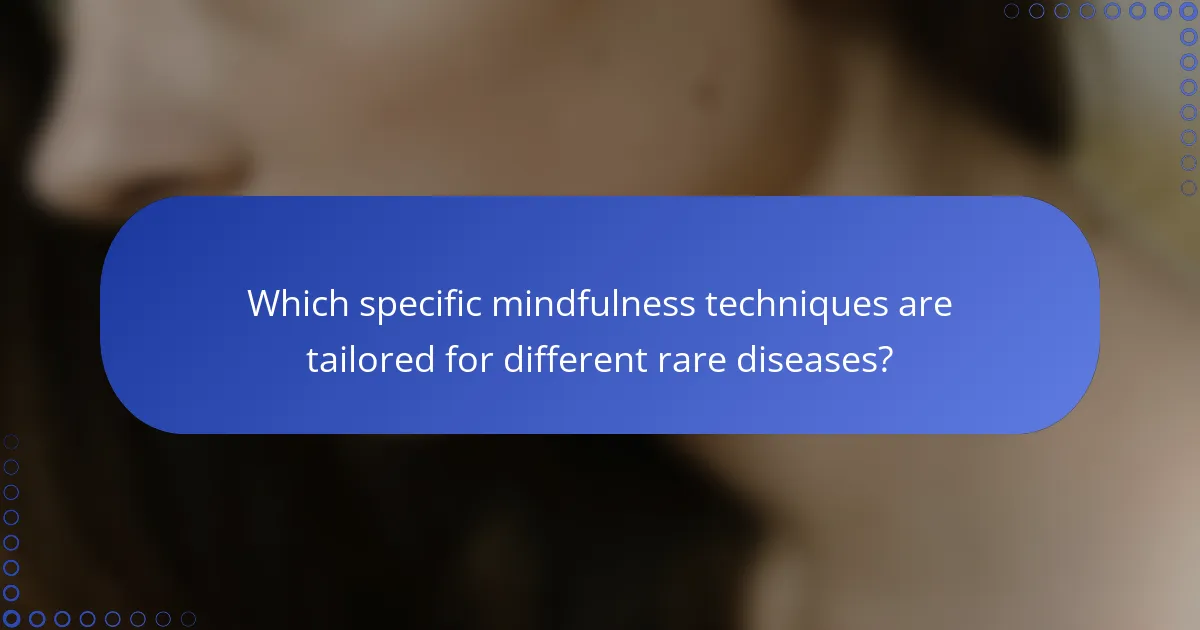
Which specific mindfulness techniques are tailored for different rare diseases?
Mindfulness techniques tailored for rare diseases include guided imagery, body scanning, and breath awareness. These practices help reduce anxiety and improve patient outcomes by fostering emotional resilience and enhancing coping strategies. For example, guided imagery can alleviate pain in conditions like fibromyalgia, while body scanning promotes relaxation in patients with chronic fatigue syndrome. Breath awareness is beneficial for managing stress in autoimmune disorders. Each technique addresses unique patient needs, contributing to overall well-being.
How does mindfulness meditation differ in effectiveness among various rare diseases?
Mindfulness meditation shows varying effectiveness among different rare diseases due to unique patient responses. Factors influencing outcomes include disease type, severity, and individual psychological profiles. For instance, patients with chronic pain disorders may experience significant relief, while those with neurodegenerative diseases might benefit differently. Research indicates that tailored mindfulness practices can enhance emotional well-being and reduce stress across various conditions, highlighting the need for personalized approaches in treatment.
What adaptations are necessary for mindfulness practices in pediatric rare disease patients?
Adaptations for mindfulness practices in pediatric rare disease patients include simplified techniques, shorter session durations, and engaging formats. These modifications cater to the cognitive and emotional needs of young patients, enhancing their participation and effectiveness. Incorporating playful elements, such as games or storytelling, can further support their engagement. Additionally, family involvement in the practices can create a supportive environment, fostering better outcomes and emotional resilience.
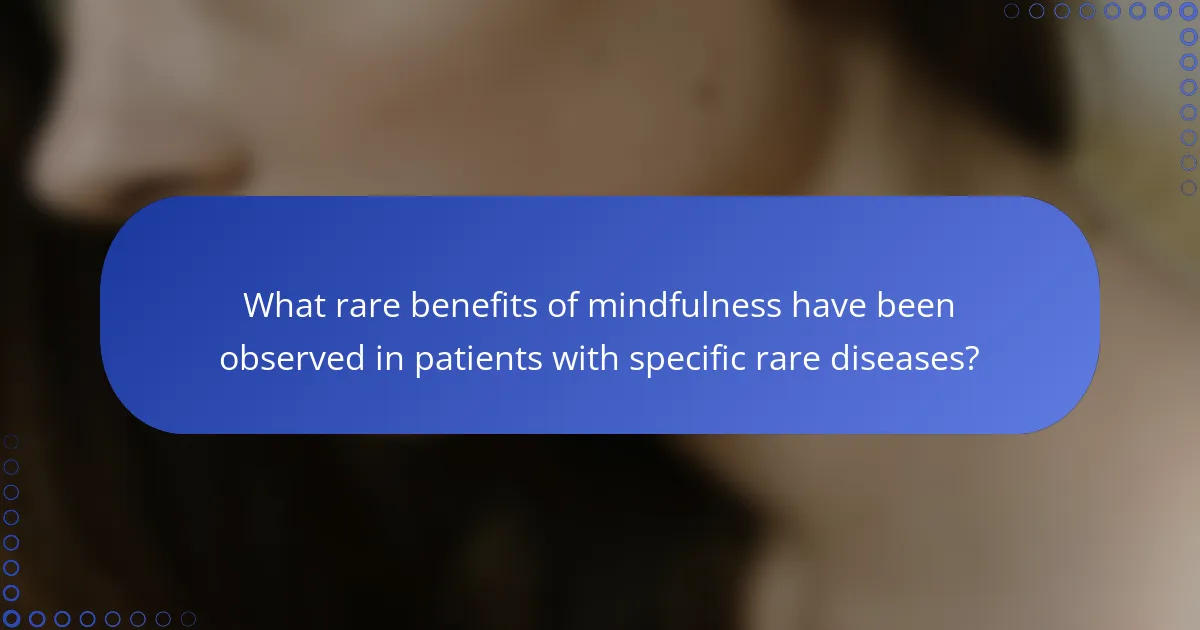
What rare benefits of mindfulness have been observed in patients with specific rare diseases?
Mindfulness practices have shown rare benefits in patients with specific rare diseases, including enhanced emotional regulation and improved pain management. For example, patients with conditions like Ehlers-Danlos syndrome reported reduced anxiety levels and greater body awareness. Additionally, mindfulness techniques have facilitated better coping strategies, leading to improved quality of life. These unique outcomes highlight the potential of mindfulness as an adjunct therapy in managing rare disease symptoms.
How can mindfulness practices lead to unexpected improvements in patient resilience?
Mindfulness practices can enhance patient resilience by fostering emotional regulation and reducing stress. Techniques such as meditation, breathing exercises, and mindful movement help patients manage symptoms and improve overall well-being. Research indicates that mindfulness can lead to a 30% increase in coping strategies among patients with rare diseases. Additionally, these practices may promote a sense of community and support, further strengthening resilience. By integrating mindfulness into treatment plans, healthcare providers can facilitate better patient outcomes and enhance quality of life.
What unique patient testimonials highlight the impact of mindfulness on rare disease journeys?
Patient testimonials reveal that mindfulness significantly enhances emotional resilience and coping strategies for those with rare diseases. For instance, one patient shared that daily mindfulness meditation reduced anxiety and improved their quality of life. Another noted that mindful breathing techniques helped manage pain during flare-ups, allowing them to maintain a sense of control. These experiences highlight mindfulness as a transformative tool in navigating the complexities of rare disease journeys.
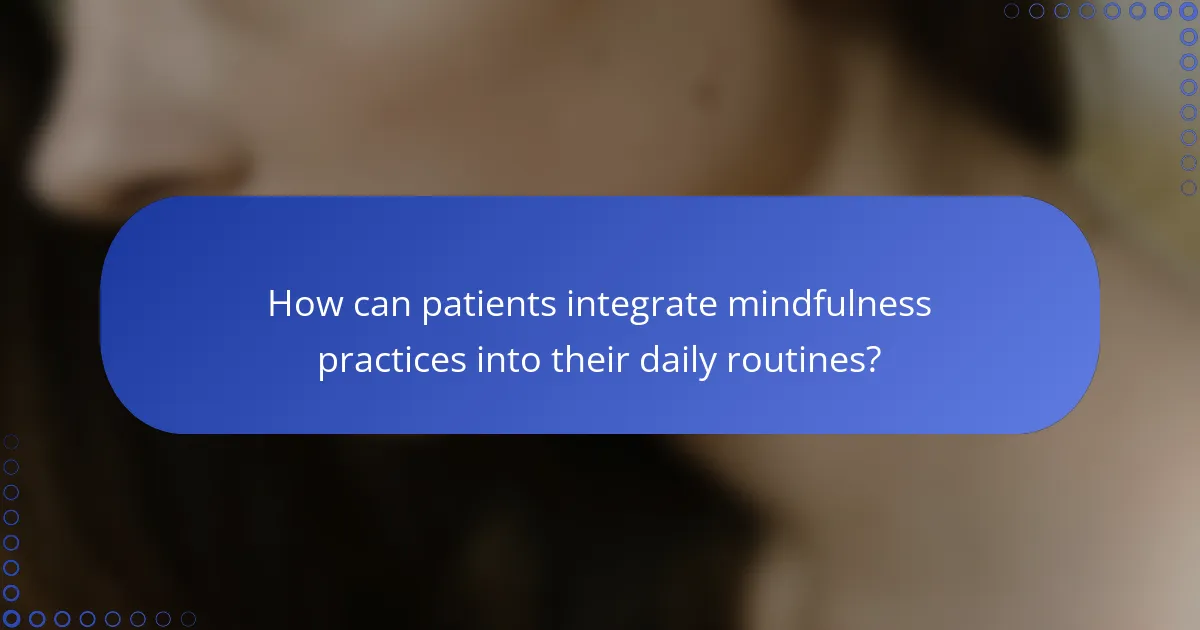
How can patients integrate mindfulness practices into their daily routines?
Patients can integrate mindfulness practices into daily routines by setting aside specific times for meditation, breathing exercises, and mindful movement. Consistency is key for effective outcomes.
1. Schedule short sessions: Dedicate 5-10 minutes each morning or evening for mindfulness.
2. Use guided apps: Leverage technology to access mindfulness resources and reminders.
3. Incorporate mindfulness into activities: Practice being present during daily tasks, like eating or walking.
4. Join support groups: Engage with others to share experiences and techniques, enhancing motivation.
These practices can improve emotional well-being and reduce stress, particularly beneficial for patients with rare diseases.
What are the best practices for creating a sustainable mindfulness routine?
To create a sustainable mindfulness routine, prioritize consistency and adaptability. Start with short, daily practices to build a habit, then gradually increase duration and complexity. Incorporate various techniques like meditation, deep breathing, and mindful movement to maintain engagement. Track progress and adjust practices based on personal needs and outcomes.
Which common mistakes should patients avoid when starting mindfulness practices?
Patients should avoid common mistakes such as setting unrealistic expectations, neglecting consistency, and overlooking personal adaptation. Mindfulness practices require patience and regularity for optimal benefits. Additionally, failing to seek guidance from trained professionals can hinder progress. Each individual’s journey in mindfulness is unique, and understanding this can enhance outcomes.
What expert tips can enhance the effectiveness of mindfulness for rare disease patients?
Mindfulness techniques can significantly enhance the well-being of rare disease patients. Focus on breath awareness, guided imagery, and body scans to foster relaxation and reduce anxiety. Establish a consistent practice schedule to cultivate resilience and improve emotional regulation. Encourage participation in mindfulness groups, which can provide social support and shared experiences. Tailor techniques to individual needs, considering unique symptoms and challenges associated with rare diseases.